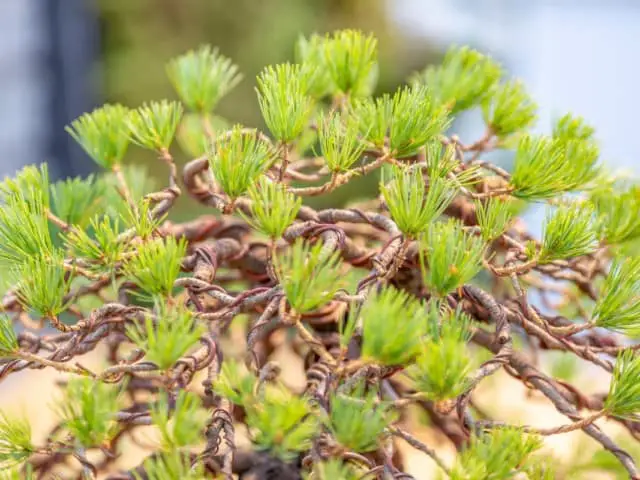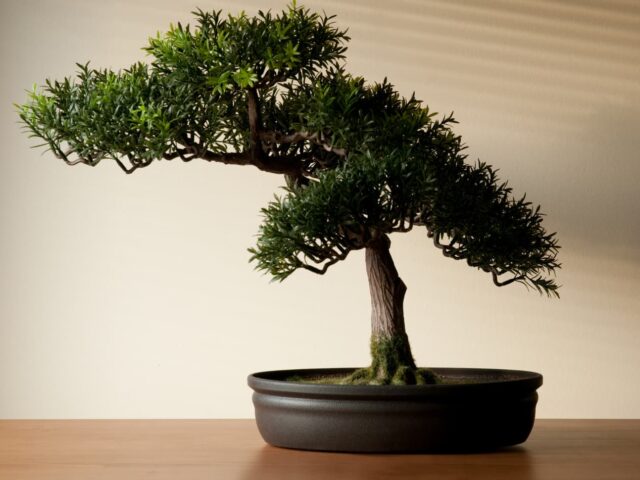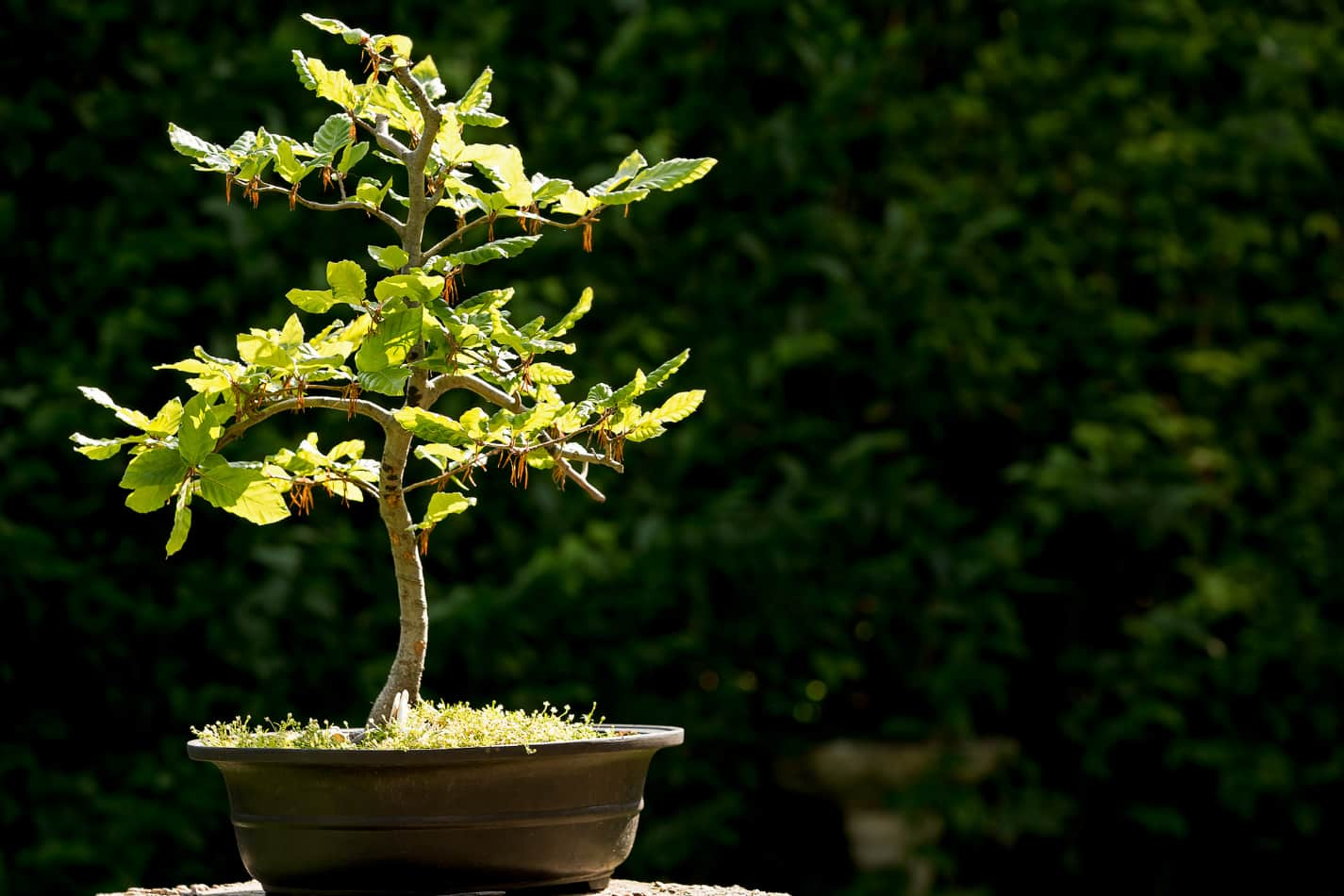You’ve probably heard various theories about how long to leave wire on a bonsai tree, but the truth is, it’s not a one-size-fits-all answer. Depending on your tree’s bark thickness, growth rate, and the climate you’re in, you might find yourself removing the wire after just a few weeks or leaving it on for months.
It’s crucial to monitor your tree closely, looking for signs that it’s time to free it from its metallic constraints. Let’s explore the key factors that determine this delicate timing, ensuring your bonsai remains healthy and beautifully shaped.
This conversation could change the way you approach wiring forever.

Key Takeaways
- Wire should be removed within 1-4 months to prevent damage and scarring.
- Monitoring every 4-6 weeks is crucial to adjust or remove wire as needed.
- Wire duration varies by species, requiring observation and species-specific care.
- Immediate wire removal is necessary if it begins to cut into the branch.
Wiring Essentials
Mastering the art of wiring is essential for shaping your bonsai tree’s growth and achieving the desired aesthetic. The duration your wire stays on isn’t a one-size-fits-all answer; it demands your attention and flexibility.
Depending on your bonsai’s species and its vigor, wire duration can span from 1 to 4 months. Thin-barked trees, vulnerable to scarring, often necessitate wire removal around the 6-week mark to avoid damage.
Conversely, if your bonsai boasts a rough bark, it can withstand longer periods, but stay vigilant for signs of the wire biting into the flesh.
Monitoring your bonsai’s growth and the branch’s adaptation is key. It’s your responsibility to decide the precise moment for wire removal, ensuring your tree’s freedom to thrive without constraints.
Choosing the Right Wire
Selecting the perfect wire for your bonsai is a crucial step that can’t be overlooked.
You’ll need to match the wire gauge precisely to the branch’s thickness, ensuring it’s about one-third the diameter, and choose between anodized aluminum for deciduous trees or annealed copper for conifers, reflecting both the tree’s needs and the wire’s characteristics.
Mastering application techniques, including the use of raffia for added protection, will safeguard your tree as it embarks on its journey of transformation.
Wire Material Choices
When it comes to shaping your bonsai tree, choosing the right wire—whether anodized aluminum for its flexibility or annealed copper for its durability—is essential for achieving the desired form and health of your tree.
The material of the wire you select plays a pivotal role in this creative journey. Aluminum wire, celebrated for its malleability, suits deciduous trees perfectly, allowing for delicate adjustments without straining the branches. Its variety in sizes, from 1mm to 4mm, caters to different branch thicknesses efficiently.
On the other hand, annealed copper wire, with its unparalleled strength, is the go-to for conifers, providing the necessary support for thicker branches or more intensive shaping. Each choice in wire material brings you closer to realizing the vision you have for your bonsai.
Wire Gauge Selection
After exploring the significance of wire material in shaping your bonsai tree, it’s equally important to consider the gauge of the wire you choose to ensure the health and beauty of your miniature masterpiece.
Selecting the proper wire gauge is a delicate balance that mandates precision. For optimal shaping, wire size should be roughly one-third the branch’s diameter.
Delicate branches crave thinner wire, whispering a gentle guide, while robust, larger branches demand thicker wire, a sturdy embrace ensuring their upright posture.
Anodized aluminum sings with deciduous trees, and annealed copper wire dances with conifers. This careful selection prevents the wire from cutting into the branches, fostering healthy growth.
Embrace the freedom to sculpt your bonsai with confidence, knowing you’ve chosen the right wire gauge for a vibrant, unencumbered future.
Application Techniques
Diving into the heart of bonsai sculpting, you’ll find that mastering the art of wire application hinges on choosing the right wire size for each unique branch. Selecting the ideal wire size, typically 1/3 the branch’s diameter, is crucial.
Anodized aluminum wire, perfect for wiring bonsai with delicate deciduous trees, offers flexibility and strength. For conifers, opt for the resilience of annealed copper wire. Starting with smaller wire sizes like 1mm, 1.5mm, 2.5mm, and 4mm adjusts to varying branch thickness seamlessly.
Timing Your Wiring
Understanding the optimal timing for wiring your bonsai tree is crucial, as it directly influences the tree’s health and the effectiveness of shaping efforts.
The duration wire can stay on varies significantly, dependent on your tree’s unique characteristics. Thin-barked beauties, like Japanese maples, demand your vigilance; they require wire removal after merely 6 weeks to dodge unsightly scars.
Conversely, trees with rough bark possess a remarkable resilience, healing from wire scars more rapidly, thereby granting you the liberty to leave the wire longer for precise branch setting. You must watch closely, balancing between promoting growth and avoiding damage.
Young, vigorous trees embrace wire quickly, setting into desired shapes with speed, while their elder counterparts plead for a gentler, sooner release.
Mastering this timing is your key to sculpting your bonsai with freedom and finesse, ensuring a thriving, beautifully shaped miniature masterpiece.
Application Techniques
You’ll find that mastering application techniques is essential for the health and beauty of your bonsai.
Selecting the right wire is your first step, ensuring it’s sturdy enough to guide but gentle enough not to harm.
Proper wire wrapping, combined with timely observation, transforms your bonsai into an exquisite art piece, reflecting your dedication and skill.
Choosing the Right Wire
Selecting the appropriate wire for your bonsai is a critical step that determines both the ease of application and the ultimate success of shaping your tree.
For deciduous trees, anodized aluminum wire is commonly used due to its flexibility and ease of handling. If you’re working with conifers, however, annealed copper wire is your best bet. It’s strong, holding those steadfast branches in place with unyielding grip.
Remember, the journey of wiring your bonsai tree starts with choosing the right wire sizes—ranging from delicate 1mm to robust 8mm. For those thicker branches that demand extra care, wrapping them in raffia before wiring protects and nurtures.
Starting with smaller wire sizes like 1mm and gradually moving up allows for meticulous, passionate shaping, ensuring your bonsai tree not only survives but thrives.
Correct Wire Wrapping
After choosing the right wire for your bonsai, mastering the technique of wire wrapping is crucial to sculpting your tree with precision and care.
You’ll start at the base, wrapping the wire around your bonsai’s branches at a 45-degree angle, ensuring a secure attachment. This angle is your blueprint to freedom in the shaping process, allowing your creativity to flourish without harming your tree.
Select wire that’s about 1/3 the thickness of the branch to maintain a balance between strength and gentleness. Apply gentle pressure as you spiral up, protecting the bark from damage.
When it’s time to free your bonsai from its wired constraints, cut the wire at each turn, liberating your tree while preserving its form.
Embrace this process, for it’s the heart of bonsai artistry.
Timing and Observation
Understanding the precise timing for wire adjustments on your bonsai is crucial, as each species responds differently to the shaping process.
You’ve got to watch the wire carefully, especially during active growth periods. This vigilance ensures you’re not just reacting, but actively engaging with your bonsai’s development.
It’s not a one-size-fits-all; the timing deeply depends on the species you’re nurturing. Some trees might whisper their readiness in 3 months, while others stretch it out to a year. It’s your passion that turns this observation into an art form.
As you monitor your bonsai’s health and growth, you’ll know when it’s time to re-wire the tree, ensuring it thrives under your watchful eye, free to grow yet guided by your hands.
Monitoring Progress
Monitoring your bonsai’s wired branches regularly is crucial to prevent the wire from cutting into the bark and causing damage. You’re the guardian of these miniature marvels, and it’s your responsibility to ensure their freedom to grow without harm.
Every 4-6 weeks, you must become an attentive observer, checking if the wire is becoming a restraint rather than a guide. If the wire starts to dig into the branches, it’s a signal to remove it immediately to prevent any lasting scars that can mar your bonsai’s beauty.
Rewiring branches that haven’t yet set or need more shaping is essential. Adjusting the wire tension and its position allows you to delicately steer the growth, maintaining the desired shape. This process isn’t just maintenance; it’s an art, requiring a keen eye and a gentle hand.
Removing the Wire
When the time comes to liberate your bonsai from its metallic constraints, remember that removing the wire within 1-4 months is crucial to prevent any lasting scars on your miniature masterpiece.
Cutting the wire at each turn rather than unwinding ensures you avoid damage to the branches, embodying a meticulous yet gentle approach.
It’s vital to eschew the temptation to recycle wire for future use; this practice might compromise the integrity of your bonsai’s delicate limbs.
Regularly monitoring the wired branches during the growing season underscores your commitment to its well-being, allowing you to act swiftly and remove the wire before it imprints scars.
This precise, passionate care guarantees the health and aesthetics of your bonsai, ensuring its freedom and beauty for years to come.
Aftercare and Maintenance
Having liberated your bonsai from its metallic constraints, it’s crucial to focus on its aftercare and maintenance to ensure its continued health and vigor.
After the careful removal of bonsai wire, it’s essential to monitor your tree closely. The wiring process, while shaping your bonsai, can stress it. Now, freed from the wires, your bonsai needs nurturing to heal and strengthen.
Diligently check for any signs of stress or damage and address them promptly. Remember, removing wires is just the start. The real art lies in the aftercare and maintenance that follows.
It’s about respecting the journey your bonsai has undertaken and guiding it towards flourishing without the confines of its previous restraints. Let your bonsai breathe freely, grow robustly, and embody the essence of resilience.
Conclusion
In conclusion, mastering the art of wiring your bonsai is key to sculpting its form with precision and care.
You’ll need to choose the right wire, apply it with technique, and monitor your tree’s growth vigilantly.
Time the removal perfectly to prevent scarring, especially for delicate barks.
Remember, the journey doesn’t end with unwiring; aftercare is crucial.
Be passionate, patient, and precise in every step, ensuring your bonsai thrives and displays your dedication in its magnificent stance.







